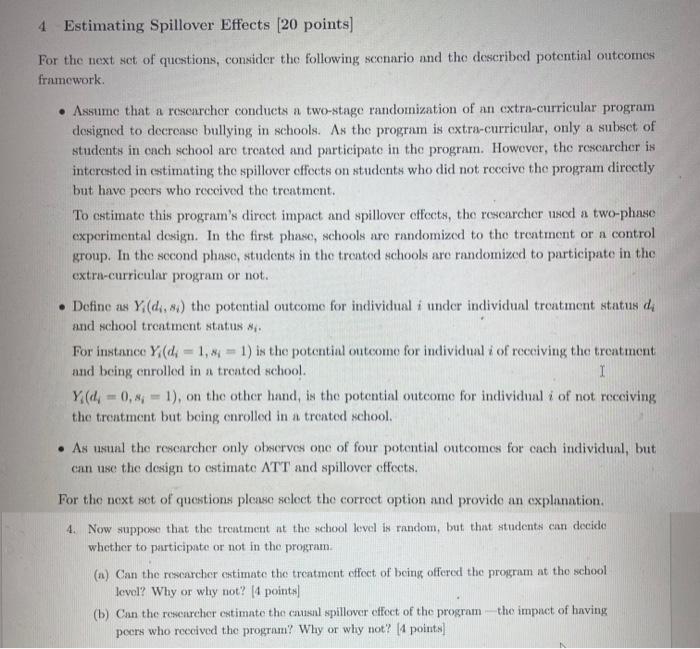For the next set of questions, consider the following scenario and the described potential outcomes framework. - Assume that a rescarcher conducts a two-stage randomization of an extra-curricular program designed to decrease bullying in schools. As the program is extra-curricular, only a subset, of students in each school are treated and participate in the program. However, the rescarcher is interested in estimating the spillover effects on students who did not reccive the program directly but have peers who received the treatment. To estimate this program's direct impact and spillover effects, the rescarcher used a two-phase experimental design. In the first phase, schools are randomized to the treatment or a control group. In the sccond phase, students in the trented schools are randomized to participate in the extra-curricular program or not. - Define as Yi(di,si) the potential outcome for individual i under individual treatment status di and school treatment status si. For instance Yi(di=1,si=1) is the potential outeome for individual i of receiving the treatment and being enrolled in treated school. Yi(di=0,si=1), on the other hand, is the potential outcome for individual i of not receiving the treatment but being enrolled in a treated school. - As usual the rescarcher only observes one of four potential outcomes for each individual, but can use the design to estimate ATT and spillover effects. For the next set of questions please select the correct option and provide an explanation. 4. Now suppose that the treatment it the sehool level is random, but that students can decide whether to participate or not in the program. (a) Can the rescarcher estimate the treatment effect of being offered the program at the school level? Why or why not? [4 points] (b) Can the reseurcher estimate the causul spillover effect of the program - the impact of having peers who received the program? Why or why not? [4 points] For the next set of questions, consider the following scenario and the described potential outcomes framework. - Assume that a rescarcher conducts a two-stage randomization of an extra-curricular program designed to decrease bullying in schools. As the program is extra-curricular, only a subset, of students in each school are treated and participate in the program. However, the rescarcher is interested in estimating the spillover effects on students who did not reccive the program directly but have peers who received the treatment. To estimate this program's direct impact and spillover effects, the rescarcher used a two-phase experimental design. In the first phase, schools are randomized to the treatment or a control group. In the sccond phase, students in the trented schools are randomized to participate in the extra-curricular program or not. - Define as Yi(di,si) the potential outcome for individual i under individual treatment status di and school treatment status si. For instance Yi(di=1,si=1) is the potential outeome for individual i of receiving the treatment and being enrolled in treated school. Yi(di=0,si=1), on the other hand, is the potential outcome for individual i of not receiving the treatment but being enrolled in a treated school. - As usual the rescarcher only observes one of four potential outcomes for each individual, but can use the design to estimate ATT and spillover effects. For the next set of questions please select the correct option and provide an explanation. 4. Now suppose that the treatment it the sehool level is random, but that students can decide whether to participate or not in the program. (a) Can the rescarcher estimate the treatment effect of being offered the program at the school level? Why or why not? [4 points] (b) Can the reseurcher estimate the causul spillover effect of the program - the impact of having peers who received the program? Why or why not? [4 points]







